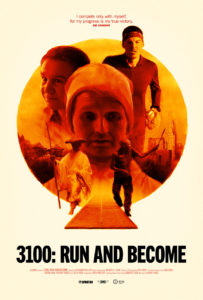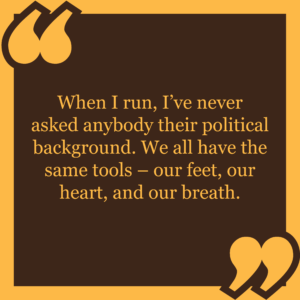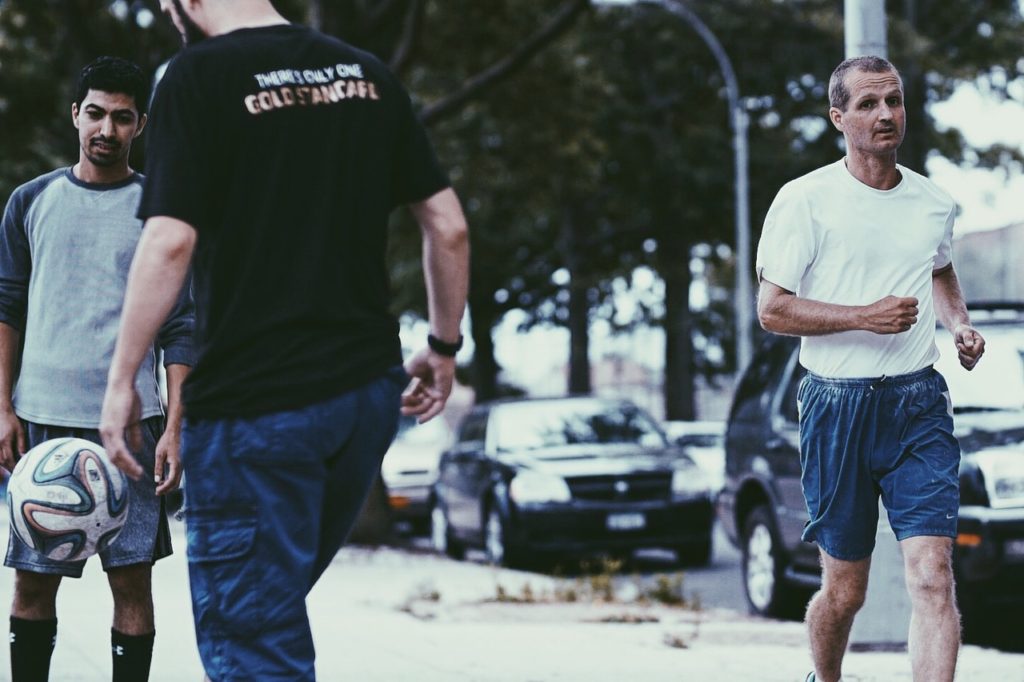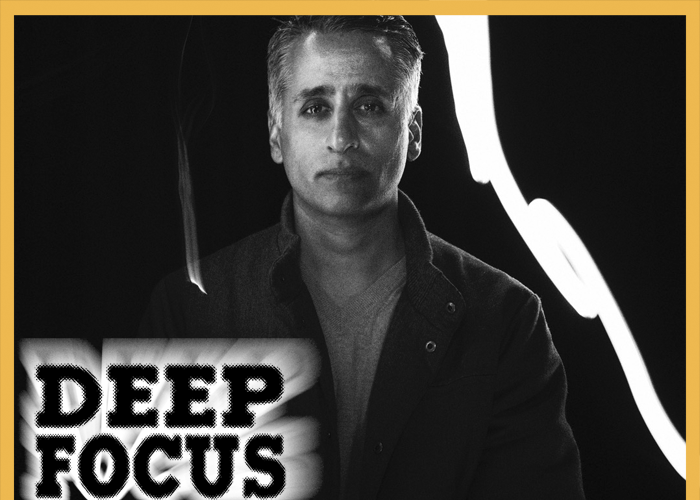 In our ongoing column Deep Focus, TrunkSpace is going behind the camera to talk with the directors, writers and producers who infuse our world with that perennial pop culture goodness that we can’t get enough of.
In our ongoing column Deep Focus, TrunkSpace is going behind the camera to talk with the directors, writers and producers who infuse our world with that perennial pop culture goodness that we can’t get enough of.
This time out we’re chatting with Sanjay Rawal, Director and Producer of the captivating new documentary, “3100, Run and Become.”
TrunkSpace: Your film “3100: Run and Become” is about what motivates endurance runners. What motivated you to tell their story?
Rawal: I’d always had a sense of what motivated people like myself to do distance running. There are moments in certain runs where we feel a sense of euphoria and lucidity. Science tries to rationalize that as a chemical high. The endorphins might be a by-product of that, but the memories of those moments also make a lasting impression on our lives. At the same time, I understood that there were a few cultures for whom running was more than a lifestyle choice or a way of life. Running is seen as a tool for enlightenment; complete unity with Nature; or profound connection to one’s ancestral past. These are much deeper concepts than why most of us run. These traditional viewpoints to running are religious or deeply spiritual. I wanted to show modern runners what these spiritual running traditions looked like in practice. And hence, we managed to get access to Navajo spirit runners, to Kalahari Bushmen and to the monks who traverse the highlands of Japan. And we wrapped these ancestral traditions in the modern arc of runners trying to harness their deepest spiritual reserves to try to run 3,100 miles in the world’s longest running race – a race in New York City that was, in fact, started by an Indian Spiritual Master, Sri Chinmoy. This race, now in its 22nd year, requires participants to average 60 miles a day within the 52 day window. It is mind-blowing, extreme and beautiful all at the same time.
TrunkSpace: This seems like the kind of film where so much of the story begins to tell itself through the subjects that you’re featuring. You almost won’t know what you have until you have it. What surprised you most throughout the process in terms of the narrative direction that the film took?
Rawal: Your perception is spot-on. We spent a year trying to develop access to the traditional aspect of the film – the Navajo, Bushmen and the Monks of Mt. Hiei, Japan. We had an intuitive feeling that the stories would all go together but we had no concept of how well they would until we were on location. And these were all expensive places to shoot. We basically went for broke. And we filmed most of these well before the 2016 edition of the 3100-miler started.
At the same time, the Self-Transcendence 3100 Mile Race is a race – and the results were totally unpredictable ‘til the end. We couldn’t burden runners with microphones and dozens of cameras so we had to film very judiciously. We were constantly juggling narratives as the race was developing.
The most surprising aspect of the filmmaking process was seeing how well those traditional narrative arcs were syncing with the 3100. And we began to cherry pick aspects of the 3100 that summer that had overlaps with the footage we’d shot. It was a very dynamic and exciting process to say the least!
TrunkSpace: So much of the success of the film also seems to hinge on how engaging your subjects are to the audience. When did you know that Ashprihanal Aalto and Shamita were going to be able to carry the film in a way that would captivate viewers?
Rawal: That’s nice of you to say! We had wanted to make a documentary that felt like a narrative in its visual style and storytelling technique. We knew that with such disparate locations and stories that didn’t overlap, we had to make decisions as to our main characters very early on. I had known Ashprihanal and Shamita for almost 20 years and it was clear to me that we would be able to film scenes to the strengths of the two. And I knew enough of their motivations that we were able to focus on what I felt would be their greatest strengths and weakness during the race as we filmed them months before. In essence, we knew that their conflicts and personal motivations in life would only be heightened by the struggle during the race. We realized we could build arcs through their normal life and their race experience through my own knowledge of their unique personalities.
stories that didn’t overlap, we had to make decisions as to our main characters very early on. I had known Ashprihanal and Shamita for almost 20 years and it was clear to me that we would be able to film scenes to the strengths of the two. And I knew enough of their motivations that we were able to focus on what I felt would be their greatest strengths and weakness during the race as we filmed them months before. In essence, we knew that their conflicts and personal motivations in life would only be heightened by the struggle during the race. We realized we could build arcs through their normal life and their race experience through my own knowledge of their unique personalities.
TrunkSpace: As a documentary filmmaker, is it a balancing act to present the narrative and facts as they unfold, but at the same time, find a way of presenting it all in an engaging way?
Rawal: You’re absolutely correct in highlighting this. In documentary filmmaking we are obviously dealing with real people. And filmmaking concentrates certain aspects of the personalities of our characters in a way that distorts their reality – and remains as a lasting public record. The whole approach is essentially exploitative. Since many of the subjects were friends of mine beforehand and the others became friends, we had to balance facts with the sensitivity of the ramifications that those facts would have on our characters. Our characters were very sharing with us. Perhaps their physical suffering of racing opened them up more than they normally would’ve been. We had to balance what they told us with what we felt they’d be comfortable with us sharing. It was a very delicate process – revealing enough of our characters to engage an audience, but respecting the sacrifice our subjects made in sharing their lives with us.
TrunkSpace: It feels like a film like this would have a lot of visual and technical obstacles to overcome. Is that something you faced and how did you approach those hurdles as they were presented to you?
Rawal: We wanted from the beginning to make a doc that looked like an indie narrative. Our DP, Sean Kirby, is a master at this. The biggest obstacle was the fact that running is incredibly boring to watch. Sean made it a point to ensure that each day he spent on the 3100 mile race course, he’d try to approach the shoots with a different look in mind. At the same time, filming in Japan, Botswana and the Navajo Nation presented unique challenges. Unlike the 3100 where subjects repeat their loops over and over, we had to capture live footage in real time with visual perfection. We wouldn’t get a second chance. In Japan, we rehearsed shots and angles multiple times so that when the monk was on location, we knew what we needed. On the Navajo Nation, we did the same. We rehearsed our drone shots and fixed shots with stand-ins before our main character did a 110 mile tribute run. In Botswana, our cameramen Omar Mullick and Forest Woodward just did what they could to keep up with our characters as we chased large game down by foot over the span of dozens of miles.

TrunkSpace: What was the biggest stumbling block you had to face throughout the process of making the film? Was there ever a moment where you thought that it may not see the light of day?
Rawal: Although I would have liked to believe that I storyboarded the film in its entirety, interweaving these narratives proved much more difficult than I could’ve imagined. Thankfully we had an incredible editor, Alex Meillier, who spent months dissecting the various narrative possibilities of the film and finding ways to make them naturally fit with one another. We studied films together, classic tandem narratives like Robert Altman’s “Nashville,” Haggis’ “Crash” and others. At the same time, with such a mélange of characters in such an unusual film, and without the celebrity that many other sports films have, we have had to work doubly hard to get the film out there. We didn’t make it into any of the classic festivals, all of which films from my team have exhibited in at one point or another. Even after making the film, and feeling very proud of what we had done, there was part of me that thought that we would never be able to get it out there because so many of the gatekeepers in the industry were unsupportive. At the same time, audience members have driven 4, 5, 6, or 10 hours to theaters to see the movie. Audience reactions have been off the charts and very heartening to myself, my producer Tanya Meiller and to Sean and Alex.
TrunkSpace: What are you most proud of with the film?
Rawal: That is very kind question of you to ask. I’m really proud of the reaction our subjects have given the film. While I’m not a Native American and the film isn’t a solely indigenous film, one of our main characters is from the Navajo nation. The reactions that we have gotten in Indian country have been spectacular. We filled theaters in some of the most unlikely locations – and over and over and over. Native Americans seem to see this film as emblematic of the importance they have given to running across millennia. And I’m really proud to feel that we have done their story justice.
TrunkSpace: What did filmmaker Sanjay learn throughout the process of bringing “3100: Run and Become” together, and beyond that, what did human Sanjay discover? What did you learn about yourself or life, which in itself is a bit like an endurance run that we’re all involved in?
Rawal: In this day and age it seems like the divisions between people, particularly in United States, are insurmountable. And I think on a mental or experiential level they are. The fascinating thing to me is that there are a handful of activities that do not depend on race, economic background, or religion. When I run, I’ve never asked anybody their political background. We all have the same tools – our feet, our heart, and our breath. At the same time there are other great uniting forces or activities like food and like music. There is power in these practices they have brought humans so much joy for so many hundreds of thousands of years. On some level, I think we need to find a way to make these types of activities a more regular part of our experiences with one another. Our Navajo character Shaun Martin says that running is a prayer, running is a teacher, and running is a celebration of life. It is one of the most unique activities on earth in the sense. In that aspect, your parallel between running and life is totally appropriate. We have to find ritual and meaning in the small things we do together, we have to realize that life is teaching all of us something unique, and we have to celebrate this journey that we are all on together.
TrunkSpace: Some people love to run. Others hate it. What would you say to the latter group to get them to sit down and watch the film? What will they find in it that goes beyond running itself?
Rawal: Shaun Martin, our Navajo character, taught me something very unique. And it bears repeating. Running is a prayer. When we run our feet pray to Mother Earth and we breath in Father Sky. Running is also a Teacher. It teaches us who we are. When we run we’re also celebrating our own lives and being alive. I think those three things are uniquely human reactions that are worth celebrating.
And, in a sense, our film itself is a celebration of life with Navajo, Bushmen, Monks, Europeans and Americans. Running is just the common thread. But running shows how these totally disparate cultures are united. And, to me, that gives me hope that we’ll recognize on many other levels all the things that can unite us.
TrunkSpace: What’s next for you as a filmmaker? Where is your creative focus these days?
Rawal: I have come across a story that is too good not to tell as a narrative. I think it would be an absolutely stunning documentary but I think it could be a revelatory narrative film. It is the story of a native American female runner that few seem to remember, but in the late ‘70s she was the most dominant runner in the world. She overcame some of the most horrific traumas that anyone could deal with, but the same time she had and still has the heart of a champion. I can’t wait to develop that story into a script and find a way to bring it to the larger world – the story of Patti Dillon.
“3100, Run and Become” opens in NY tomorrow and in Los Angeles on November 9. For more information, click here.


